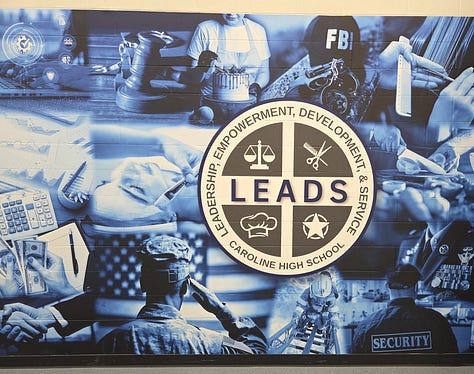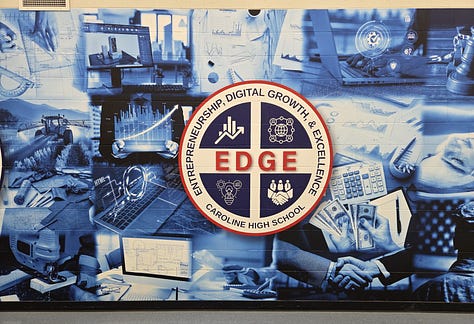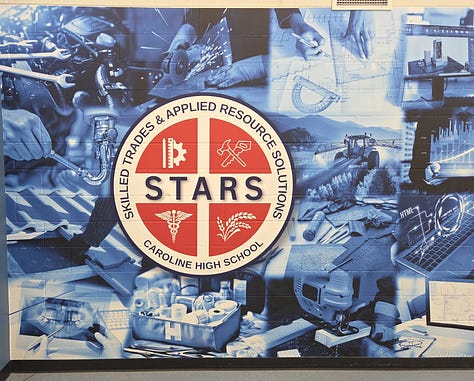Academy Forges Workforce Training, Academics
Caroline High School is rethinking academic and technical education, creating multiple pathways for students to succeed.
By Martin Davis
EDITOR-IN-CHIEF
Email Martin



Think back to your high school days, and what do you remember?
Too often, academics are not the first thing that will come to mind. Athletics, friends, parties are more likely to rise to the top of the list.
Caroline High School “wants to change that experience for every” student, says Principal Tom Connelly, and Academy is how Connelly and his team are looking to affect that change.
The program, now in its second year, is borrowed from schools in Lexington, Kentucky, where Caroline County school leaders visited with the Fredericksburg Chamber of Commerce to learn about the program.
In Virginia, there’s a renewed emphasis on graduates ready for one of three “Es” — Enrolled, Enlisted, Employed.
Academy takes that approach a step further.
The goal, said Autumn Nabors, director of secondary education, is for “our kids to be all three — Employed, Enlisted, Enrolled.”
Setting the Stage
The Academy program spans all four years of high school. Caroline County launched it last year with its incoming freshman class, and all students will be involved in two years.
Incoming freshmen are divided into two teams — blue and red (the school colors).
The placements are quasi-random, meaning the district tries to ensure that all the athletes or STEM students aren’t on one team. Rather, the idea is to mix students so that the two groups mirror one another in terms of demographics and interests.
Each cohort has its own teachers — and teachers and teams don’t cross during a student’s four-year stay.
This helps create a sense of belonging, says Connelly. At 1,279 students, “we’re not a huge high school, but students can still get lost.”
Every freshman takes a seminar — career strategies — that introduces them to the choices before them their sophomore year.
Leaning In
Entering their sophomore year, students select an academy to enter. Each academy offers a related set of career pathways. The academies and their pathways are:
LEADS Academy — offers career clusters that emphasize service, leadership, and community engagement. Career Clusters:
Education and training
Hospitality and tourism
Human services
Law, public safety, corrections and security
EDGE Academy — career clusters focus on creativity, innovation and effective communication. Career Clusters:
Arts, A/V technology, and communications
Business management and administration
Information technology
Government and public administration
STARS Academy — designed to provide practical skills and knowledge that can be applied immediately in the workforce or serve as a foundation for further education. Career Clusters:
Science, Technology, Engineering and Mathematics
Architecture and construction
Agriculture, food and natural resources
Transportation distribution and logistics
Health science
With such an array of offerings, an immediate question becomes how the school balances all of this with the regular academic requirements demanded by the state for graduation.
Here is where the program’s innovation shines.
Three Classes, and …
Rather than forcing students into career tracts, Academy is only “asking kids to commit to three classes in a row out of the 32 that are required,” said Connelly.
So a student who chooses health science would be committing to one course each year in that area. The remaining 29 classes are the same required courses and electives that all students in Virginia are mandated to take.
What is distinctive about Academy is that teachers are being trained in project-based learning, and they work to find ways to integrate students’ interests into their regular coursework.
“We want to try and integrate content so that students know how it relates to their career pathway and plan,” said Nabors.
So how does this all come together?
If a student selects nursing as the area of interest, they would take health related courses each of their sophomore, junior, and senior years. More important, in their regular academic classes, teachers are looking for ways to tie students’ career interests to the work they’re required to do.
“By the time you’re a senior, said Connelly, “we’re looking for work-based learning placement. Hands-on, in the world experience.”
For some of the pathways, the required classwork may be outside the classroom.
Students in the sports medicine program, for example, work after school with athletes and the medical staff to earn their course credits.
Too Much Career?
For years, the complaint has been that high school is too geared toward college, leaving career technical education to the side. Does Academy swing the gate too far in the other direction?
“No,” said, Nabors. If students want to load up on AP and Dual Enrollment classes, they can certainly do that. They’re still pursuing a pathway and gain the benefits of that experience.
And for the enlistment part?
According to Connelly, all students take the ASVAB test. Taking it doesn’t mean students are required to join the military, but it does show them options.
A STEM student, for example, may perform high and learn that the Air Force is not only a good fit, but a good pathway to pay for college.
It’s all about creating options for students.
Is It Working?
By creating a system that creates smaller, tighter-knit communities within the school, and structuring classes so that students can lean into their interests, the idea is that students will make friends faster, connect to teachers better, and do better in the classroom.
It’s too early at this moment to speak to the academic outcome. Last year’s freshmen have just started their sophomore year. By next year, however, there should be enough SOL data to know if these students are performing better than students who did not go through the program.
But there are other indications that, in fact, students are thriving under the new system.
Among the current cohort there were 227 major discipline referrals that required students being removed from class their freshman year.
When that cohort became sophomores, the number of major discipline referrals fell to 94.
Connelly feels that in addition to students buying into the program and having their interests held better, teachers are also connecting better to students.
“Teachers (in academies) meet monthly,” he said, “to talk about what they’re doing in the classrooms.” And they can talk about the students that they’re struggling with and learn from others who are having more success.”
Most important, however, is that these students are building high school careers that they will look back on and not only remember the fun times, but will also remember the options put before them that helped launch successful adult lives.
Local Obituaries
To view local obituaries or to send a note to family and loved ones, please visit the link that follows.
Support Award-winning, Locally Focused Journalism
The FXBG Advance cuts through the talking points to deliver both incisive and informative news about the issues, people, and organizations that daily affect your life. And we do it in a multi-partisan format that has no equal in this region. Over the past year, our reporting was:
First to break the story of Stafford Board of Supervisors dismissing a citizen library board member for “misconduct,” without informing the citizen or explaining what the person allegedly did wrong.
First to explain falling water levels in the Rappahannock Canal.
First to detail controversial traffic numbers submitted by Stafford staff on the Buc-ee’s project
Our media group also offers the most-extensive election coverage in the region and regular columnists like:
And our newsroom is led by the most-experienced and most-awarded journalists in the region — Adele Uphaus (Managing Editor and multiple VPA award-winner) and Martin Davis (Editor-in-Chief, 2022 Opinion Writer of the Year in Virginia and more than 25 years reporting from around the country and the world).
For just $8 a month, you can help support top-flight journalism that puts people over policies.
Your contributions 100% support our journalists.
Help us as we continue to grow!
This article is published under Creative Commons license CC BY-NC-ND. It can be distributed for noncommercial purposes and must include the following: “Published with permission by FXBG Advance.”













